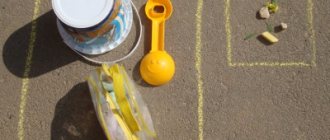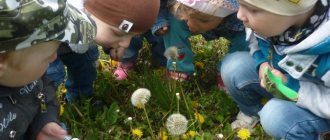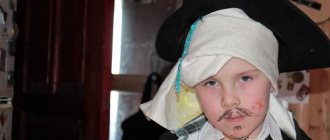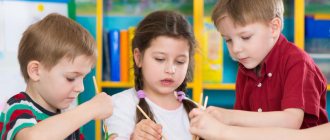Long-term planning for the formation of CGN for young children
Long-term planning of work on the formation of CGN for young children
First quarter
Nutrition
Game situation
“How mom taught the bear to eat properly”
Goal: Learn to hold a spoon in your right hand, take food with your hands, and eat with the help of adults.
Reading nursery rhymes
“Okay, okay”, “Clever Katenka”, “Goyda, goyda”
Didactic games:
“Let’s show the doll how to hold a spoon correctly.”
Questioning parents
Consultations for
parents “Formation of CGN in children 2-3 years old”
Parent meeting on the topic: “What self-service skills can be instilled in young children”
Folder moving: “The importance of cultural hygiene skills in the life of your child”
Dressing and undressing
Didactic game
: “Let’s dress the doll for a walk”
Purpose: Using a toy character as an example, teach how to get street clothes out of the closet. Encourage them to put on socks, leggings, a sweater, a jacket, a hat.
Didactic exercise
: “The shoes quarreled and became friends”
“Let’s make an accordion out of a sock,” “Let’s show a doll, a bunny, a bear where our things are. Reading the nursery rhyme “Our little Masha”, Z. Alexandrova’s “Katya in the manger”
Didactic games in the doll corner: “
Let’s undress the doll after the walk”, “Put the clothes in their places”, etc.
Washing neatness skills
Game situation:
“Water, water.”
Goal: Learn to take soap from a soap dish, with the help of adults, soap your hands, put the soap in place, rub your palms together, wash off the soap, know the location of your towel, dry your hands with the help of an adult, teach to use a handkerchief.
Didactic exercise
: “How we wash our palms and wring out our hands.” Conversations based on story pictures. Reading the nursery rhyme “Water-water...”, “The swans-geese were flying...”
Looking at pictures:
“How children wash their hands,” “Mom washes her daughter.”
Didactic games:
"Show me your towel"
Children's games in a doll corner with hygiene items.
Second quarter
Nutrition
Game situation:
"Masha is having lunch."
Goal: To consolidate the ability to hold a spoon in the right hand, take food with the lips, bite it into small pieces, chew with molars and not with front teeth.
Reading a nursery rhyme:
“There goes the horned goat”, “The cat went to the market”, “Little kitten murysonka”, Z. Aleksandrova “Delicious porridge”
Role-playing game:
"Visiting the bear"
Game situation:
"We're having lunch". Children's games in a doll corner with tableware.
Consultation for parents:
"Age characteristics of young children"
Consultations:
“How to teach a child to wash his hands (get dressed), etc.?”;
Design of a photo exhibition
“We love, we love to wash our face in the mornings and evenings!!”
Dressing and undressing
Game situation: "
Button up the button."
Goal: Learn to unfasten Velcro fasteners, practice using other types of fasteners. Learn to put on shoes, leggings, button a jacket with the help of an adult, and hang clothes in a closet. When undressing before going to bed, take off your dress or shirt, then your shoes, learn how to remove tights correctly, and hang clothes on a chair. Continue to teach how to behave properly in the locker room.
Game situation:
"How the cockerel woke up the children."
Didactic exercise
: “Let’s put the doll to sleep.”
Reading: Z. Aleksandrova “My Teddy Bear”.
N. Pavlova “Whose shoes”
Game situations for a story game:
– Tanya doll is visiting us; Situations for discussion: - how the hat quarreled with the jacket in the closet.
Conversation with parents:
"How
instill independence"
Album design with the participation of parents “Poems, nursery rhymes - helpers in raising children.”
Washing neatness skills
Theme: “Good morning, comb!”
Goal: developing skills in using a comb and caring for it. Continue to teach how to soap your hands and wash them with straight movements, and learn to wring out your hands after washing. Strengthen the ability to dry your hands with your towel.
Exercise game
“Doll Tanya has a cold.” Purpose: to show how to properly use a handkerchief.
Role-playing game:
"Salon"
Examination of the plot pictures: “Children bathing.”
Consultation for parents:
"What we read at home"
Third quarter
Nutrition
Improve the ability to eat independently, finish everything to the end, swallow food without leaving it behind the cheek. Develop neatness skills. Learn to use a napkin.
Exercise game
: “How the bear learned to eat”
Didactic exercise
: “Let’s help the animals set the table for dinner.” Reading the story “Masha is having lunch”
Children's games in the doll corner:
“Let’s set a table for the dolls”, “Katya the doll is drinking tea.”
Conversations with parents “Teaching children proper behavior at the table.”
Photo exhibition: “How I help my mother”
Dressing and undressing
Continue learning how to fasten buttons. Learn to put on socks and knee socks, starting with the toe. When undressing before going to bed, encourage him to hang his clothes on his high chair. Learn to politely express requests for help.
Game situation: "
Let’s help the doll get ready to visit the bear.”
Didactic exercise
: “Let’s teach the little animals how to fasten buttons”
We are learning poems on the topic of Dressing and Undressing:
“Masha put on a mitten”
Role-playing games
“Home” and “Family”: – introducing the game situation “Doll Katya wants to sleep.”
Didactic game
“Let's teach the doll to dress/undress”; "Dress the doll"; with subject pictures on the topic “Clothes, shoes, hats.” Examination of plot pictures “children on a walk” (at different times of the year).
Moving folders in the health corner “Clothing for the season”
Conversations with parents:
We teach children at home to dress in the correct order when going out.
Washing neatness skills
Learn to roll up your sleeves before washing and strengthen the ability to use a handkerchief and a comb. Develop the ability to freely use bedding items, use them for their intended purpose, and name them correctly; – to formulate the need to observe the rules of personal hygiene before going to bed (washing, neatly folding clothes).
Didactic exercise
: “Let’s teach the Doll how to wash himself properly,” “Let’s show the bear how to dry himself with his towel.”
Reading K. Chukovsky “Moidodyr”, E. Blagina “Alyonushka”
Game situation: "
We are giving Katya a bath.” Looking at story pictures.
Didactic games:
"Mixed Pictures" Goal: to consolidate and test cultural and hygienic skills.
Master class for parents “Bayu-bashki-bayu... (we get acquainted with the Russian folk lulling nursery rhyme, song, sentences). Sharing experiences between parents “How I put my child to sleep.”
Fourth quarter
Nutrition
Learn to hold a spoon with three fingers while eating the broth of the first course, along with the dressing, the main course and side dish. Strengthen the ability to eat carefully and improve food culture skills.
Game situation:
«
Mishkaa invited a bunny and a hedgehog to visit"
Didactic exercise
: “Let’s tell Piggy how to eat properly”
Reading S. Kaputikyan “Who will finish drinking sooner”
Role-playing game “Let’s treat the doll to tea.”
Didactic game “What does a doll need!” Purpose: to exercise cultural and hygienic skills
Screen “Your assistant in the kitchen”
Consultation
“The authority of parents is a necessary condition for the proper upbringing of children”
Dressing and undressing
Strengthen the ability to dress and undress correctly with a little help from adults, place your things in the closet, fold and hang clothes on a chair before going to bed. Continue to learn how to use different types of fasteners.
Didactic exercise
: “We’ll show you how to fold clothes before going to bed,” Let’s teach a bear how to fold things in a locker.”
Reading I. Muraveiko “I Myself”, N. Pavlov “Whose Shoes”
Collective practical activities of children
“Let’s help the doll Tanya put things back in place.” Creation of various game situations to consolidate cultural and hygienic skills.
Questioning parents
“What self-care skills did the children acquire by the end of the year?”
Washing neatness skills
Cognitive development. The theme is “Water, water...”.
Goal: to consolidate the cultural and hygienic skills that children already have.
Teach not to wet clothes while washing. Encourage combing short hair.
Reading poems by K.I. Chukovsky “Moidodyr”, A. Barto “Dirty Girl”. re-enactment
“How Moidodyr gave Vanya soap.”
Didactic game:
“Why do we need this?” (with toiletries).
Fun games with water at the Water and Sand Center: bathing dolls, fish, ducks.
Looking at photo albums.
Consultation
“How to get your child interested in daily dental hygiene?”
Ask parents to watch the film “Moidodyr” with their children
Card file on education of cultural and hygienic skills
Card index for the education of cultural and hygienic skills in the first junior group.
Card No. 1
1. Regime process: Nutrition.
Skill content
: Teach children to hold a spoon in their right hand.
Methodological techniques. Game situation: “How mom taught the bear to eat properly”
.
2. Regime process: Dressing - undressing.
Skill content
: Learn how to get outdoor shoes. Teach verbally, express a request for help, teach how to behave calmly in the locker room.
Methodological techniques. Didactic exercise: “The shoes quarreled and became friends”
.
3. Regime process: Washing.
Skill content
: Learn to take soap from a soap dish and, with the help of adults, soap your hands.
Methodological techniques. Didactic exercise “How we wash our palms and wring out our hands”
.
Card No. 2
1. Regime process: Nutrition.
Skill content
: Learn to take food with your lips.
Methodological techniques. Reading nursery rhyme: “Okay, okay”
.
2. Regime process: Dressing-Undressing.
Skill content
: Encourage to put on socks, a jacket or sweater, a jacket, a hat.
Methodological techniques. Didactic game “Dress the doll for a walk”
. Continue to teach verbally, express a request for help, teach how to behave calmly in the locker room.
3. Regime process: Washing.
Skill content
: Teach children to rub their palms together, put the soap in place.
Methodological techniques. Looking at pictures
:
. ” Conversation on them.
Card No. 3
1. Regime process: Nutrition.
Skill content
: Continue teaching how to hold a spoon in your right hand.
Methodological techniques. Reading nursery rhyme: “Okay, okay”
2. Regime process: “Dressing-Undressing”
.
Skill content
: Teach children to remove tights from the upper body. Continue to teach verbally, express a request for help, teach how to behave calmly in the locker room.
Methodological techniques. Reading nursery rhyme: “Our Masha is little”
.
3. Regime process: Washing
Skill content
: Teach children to wash off soap and know the location of their towel.
Methodological techniques. Looking at pictures
:
“Mom washes her daughter
.
Conversation on them. Reading the nursery rhyme:
. ”
Card No. 4
1. Regime process: Nutrition.
Skill content
: Continue teaching children to take food with their lips and eat with the help of adults.
Methodological techniques. Game situation: “How mom taught the bear to eat properly”
.
2. Regime process: “Dressing-Undressing”
.
Skill content
: Teach verbally, express a request for help, teach how to behave calmly in the locker room. Continue to teach verbally, express a request for help, teach how to behave calmly in the locker room.
Methodological techniques. Didactic exercise “Undress the doll after a walk”
.
Reading the nursery rhyme by Z. Alexandrov “Katya in the manger”
.
3. Regime process: Washing
Skill content
: Teach children, with the help of an adult, to dry their hands.
Methodological techniques. Looking at pictures
: Children wash their hands."
Reading the nursery rhyme: “Water-water...”
.
Card No. 5
1. Regime process: Nutrition.
Skill content
: “To consolidate the ability to hold a spoon in the right hand.
Methodological techniques. Reading a nursery rhyme: “The cat went to market”
2. Regime process: “Dressing-Undressing”
.
Skill content
: Encourage children to take off their dress or shirt, then their shoes, before going to bed. Continue to teach verbally, express a request for help, teach how to behave calmly in the locker room.
Methodological techniques. Reading “My Bear”
, N. Pavlova
“Whose shoes”
3. Regime process: Washing
Skill content
: Continue learning to lather your hands and wash them with straight movements.
Methodological techniques. Looking at the illustration “Children wash their hands”
and a conversation about it.
Card No. 6
1. Regime process: Nutrition.
Skill content
: Strengthen children’s ability to take food with their lips.
Methodological techniques. Reading nursery rhyme: “There comes a horned goat”
.
2. Regime process: “Dressing-Undressing”
.
Skill content
: Teach children how to properly remove tights and hang clothes on a chair. Continue to teach the rules of behavior in the locker room.
Methodological techniques. Reading N. Pavlov “Whose Shoes”
3. Regime process: Washing
Skill content
: Learn to wring out your hands after washing.
Methodological techniques. Didactic exercise “How we wash our palms and wring out our hands”
Card No. 7
1. Regime process: Nutrition.
Skill content
: Teach children to bite food into small pieces.
Methodological techniques. Reading nursery rhymes: “The cat went to market....”
,
“Kitsonka - purr”
2. Regime process: “Dressing-Undressing”
.
Skill content
: Learn to fasten Velcro, practice using other types of fasteners. Continue to teach the rules of behavior in the locker room.
Methodological techniques. Game situation: “How the cockerel woke up the children in the morning”
.
3. Regime process: Washing
Skill content
: Strengthen the ability to soap your hands and wash them with straight movements.
Methodological techniques. Reading a nursery rhyme: “Water, water...”
Card No. 8
1. Regime process: Nutrition.
Skill content
: Strengthen children’s ability to chew with molars, not front teeth.”
Methodological techniques. Reading a nursery rhyme by Z. Alexandrov”, “Delicious porridge”
.
2. Regime process: “Dressing-Undressing”
.
Skill content
: Learn to put on shoes, button a coat with the help of an adult, hang clothes in a closet. Continue to teach the rules of behavior in the locker room.
Methodological techniques. Didactic exercise: “Let’s put the doll to sleep”
3. Regime process: Washing
Skill content
: Reinforce the ability to dry your hands with your towel and hang it up
Methodological techniques. Didactic exercise: “Let’s show the bear how to wipe his hands and face with a towel”
.
Card No. 9
1. Regime process: Nutrition.
Skill content
: Improve the ability to eat independently, finishing everything to the end.
Develop neatness skills
.
Methodological techniques. Didactic exercise: “Let's tell Winnie the Pooh how to behave at the table.
2. Regime process: “Dressing-Undressing”
.
Skill content
: Continue teaching children how to fasten buttons. Learn how to politely express a request for help.
Methodological techniques. Game situation “How we helped the doll get ready to visit the bear. Didactic exercise “Let’s teach little animals how to fasten buttons”
3. Regime process: Washing
Skill content
: Teach children to roll up their sleeves before washing. Strengthen the ability to use a handkerchief.
Methodological techniques. Didactic exercise: “Let’s teach a bear (bunny, doll)
wash yourself properly"
Card No. 10
1. Regime process: Nutrition.
Skill content
: Improve the ability to swallow food without leaving it behind the cheek.
Methodological techniques. Reading a nursery rhyme: “I’ll bake a pie for Tanya...”
2. Regime process: “Dressing-Undressing”
.
Skill content
: Teach children to put on socks, knee socks, starting with the toe. Continue to teach, politely express a request for help.
Methodological techniques. Didactic exercise: “Let’s make an accordion out of a sock”
.
3. Regime process: Washing
Skill content
: Teach children to wash their face without splashing water. Strengthen the ability to use a handkerchief.
Methodological techniques. Reading K. Chukovsky “Moidodyr”
, E. Blaginina
“Alyonushka”
.
Card No. 11
1. Regime process: Nutrition.
Skill content
: Continue the ability to finish eating everything on your own. Learn to use a napkin
Methodological techniques. Didactic exercise “Let’s help the little animals set the table for dinner”
2. Regime process: “Dressing-Undressing”
.
Skill content
: When undressing before going to bed, encourage him to hang his dress or shirt over the back of a chair. Continue to teach, politely express a request for help.
Methodological techniques. Didactic exercise: “Let’s show the bear how to fold his clothes before going to bed”
3. Regime process: Washing
Skill content
: Continue teaching children to roll up their sleeves before washing. Teaches children to comb short hair.
Methodological techniques. Looking at the illustration “Children wash their hands”
and a conversation about it. Reading nursery rhymes.
Card No. 12
1. Regime process: Nutrition.
Skill content
: Continue children's ability to swallow food without leaving it behind the cheek. Continue learning how to use a napkin.
Methodological techniques. Game situation “How the bunny learned to eat”
Reading the nursery rhyme by E. Blaginina
“Alyonushka”
.
2. Regime process: “Dressing-Undressing”
.
Skill content
: When undressing, encourage children to put tights and shorts on the seat. Continue to teach, politely express a request for help.
Methodological techniques. Didactic exercise: “Let’s show the bear how to fold his clothes before going to bed”
3. Regime process: Washing
Skill content
: Teach children not to wet their clothes while washing. Strengthen the ability to use a handkerchief.
Methodological techniques. Looking at the illustration “Children wash their hands”
and a conversation about it. Reading Nursery Rhymes.
Card No. 13
1. Regime process: Nutrition.
Skill content
: Teach children to hold a spoon correctly with three fingers.
Methodological techniques. Didactic exercise: “Let’s tell Khryusha how to eat properly”
2. Regime process: “Dressing-Undressing”
.
Skill content
: Strengthen the ability to dress and undress correctly with a little help from adults.
Methodological techniques. Didactic exercise: “Let’s show the bear how to fold his clothes before going to bed.
3. Regime process: Washing
Skill content
: Strengthen children’s ability to wring out their hands after washing.
Methodological techniques. Didactic exercise “How we wash our palms and wring out our hands”
Card No. 14
1. Regime process: Nutrition.
Skill content
: Teach children to eat the broth
of the first
course along with dressing, the main dish and a side dish.
Continue to develop neatness skills
.
Methodological techniques. Reading by S. Kaputikyan “Who is most likely to finish drinking, “Masha is having lunch”
.
2. Regime process: “Dressing-Undressing”
.
Skill content
: Strengthen children’s ability to place their things in the closet, fold and hang clothes on a chair before bed.
Methodological techniques. Didactic exercise: “Let’s teach the bear to put things in the locker”
3. Regime process: Washing
Skill content
: Ensure that children do not get their clothes wet while washing.
Methodological techniques. Looking at pictures
:
“Greasy girl”
,
“Neat girl”
.
Card No. 15
1. Regime process: Nutrition.
Skill content
: Teach children to hold a spoon correctly with three fingers. Continue learning how to use a napkin.
Methodological techniques. Game situation “The bear invited a bunny and a hedgehog to visit”
2. Regime process: “Dressing-Undressing”
.
Skill content
: Continue teaching children how to use different types of fasteners.
Methodological techniques. Reading: And Ant “I myself”
.
Didactic exercise: “Let’s teach the little animals how to fasten buttons”
3. Regime process: Washing
Skill content
: Reinforce
hand washing and washing skills
Methodological techniques. Looking at pictures
:
“Mom washes her daughter”
Card No. 16
1. Regime process: Nutrition.
Skill content
: consolidate the ability to eat carefully, improve
food culture skills
.
Methodological techniques. Reading: S Kaputikyan “Who will finish drinking sooner”
,
“Masha is having lunch”
2. Regime process: “Dressing-Undressing”
.
Skill content
: Continue to strengthen the ability to dress and undress correctly.
Methodological techniques. Reading I. Muraveyk “I myself”
, N. Pavlova
“Whose shoes”
3. Regime process: Washing
Skill content
: Continue to reinforce
skills
. Continue combing your short hair.
Methodological techniques. Reading familiar nursery rhymes ( “Water-water...”
etc.)



